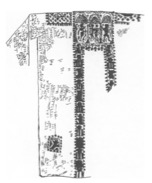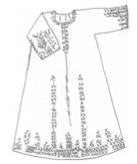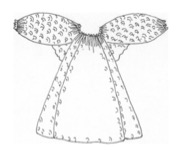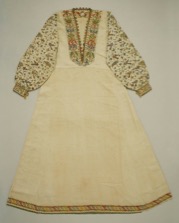Smocks in History
A smock is an undergarment that is worn between the skin and the outer garment (s) and, “over the centuries and across geographical and cultural terrain, smock, chemise, or shirt styles maintained basic similarities, while varying from excessively plain to elaborate in cut, fabric, and construction.” (Hodges, Laura F. “Reading Griselda’s Smocks in the Clerk’s Tale.” The Chaucer Review (2009), http://www.jstor.org.prox.miracosta.edu/stable/pdf/25642132.pdf). It can be made from wool, hemp, linen, fine muslin, silk or a mixed textile. Wool might be a textile with which an ascetic would have their smock fashioned out of since it would represent simplicity and a lack of indulgence: usually reserved for the most pious. The poorest even among the lower class would have worn a smock constructed of hemp and this may even have been the only garment which one owned. Since modesty is desired and expected of particularly of married women, being poor seems to automatically deem someone as impure and improper. Changes of clothing, including the smock can also signal the transformation of a social decree. In Chaucer’s, The Clerk’s Tale, one such transformation in chronicled when Griselda becomes a Marchioness, marrying a man of nobility. Below are smocks throughout history based on scholars’ drawings based on primary source descriptions of the garment.



(Left to right: Egyptian man’s smock with silk binding at neck and wrist edges, 4th century man’s embroidered shirt of linen, Ancient Greek women’s embroidered shift of cotton, http://www.jstor.org.prox.miracosta.edu/stable/pdf/25642132.pdf)


(Top: Hodges, Laura F. “Reading Griselda’s Smocks in the Clerk’s Tale.” The Chaucer Review (2009), 17th Century smock, http://www.jstor.org.prox.miracosta.edu/stable/pdf/25642132.pdf)
(Bottom: Late 16th Century, Italian smock, http://www.metmuseum.org/art/collection/search/83861)
Those involving cheaper wool (like worsteds), quicker weaving, and less finishing would indicate the status you’re discussing here. There were also many finely woven woolen garments, highly finished, that would indicate greater wealth.
There are also accounts that smocks may have also been constructed of finer textiles where they would have been visible, like the neckline and and wrists, then of lesser quality and expensive textiles for the rest of the smock and even the cheapest and lowest grade textiles for the back and loin areas. The smock may have also been deconstructed and it’s pieces used as money or for bartering as well.